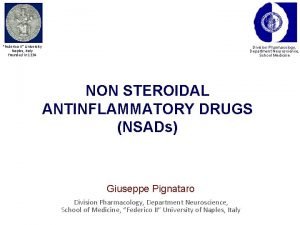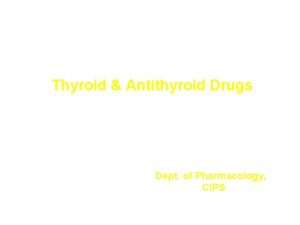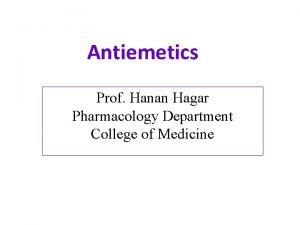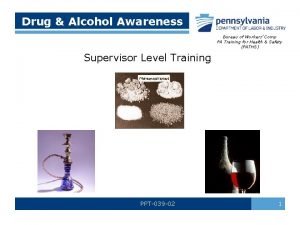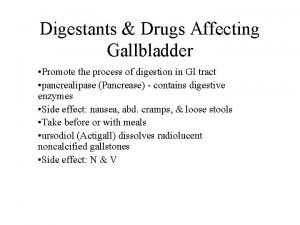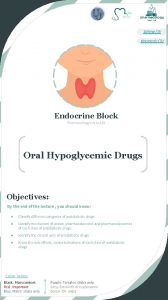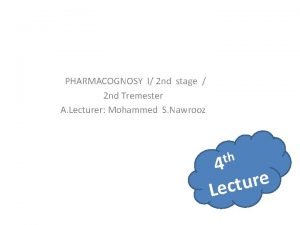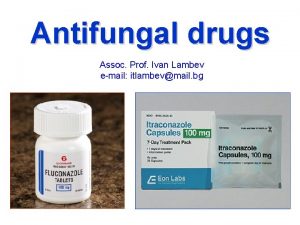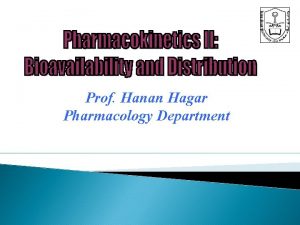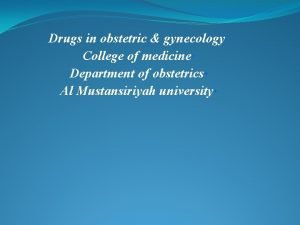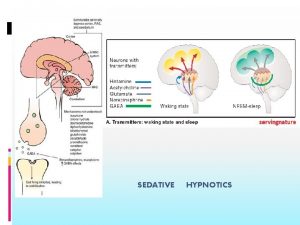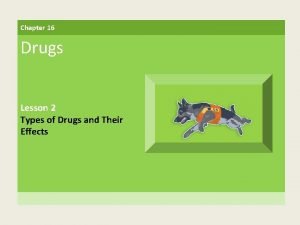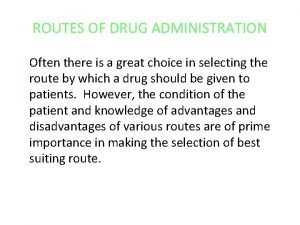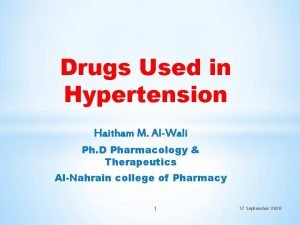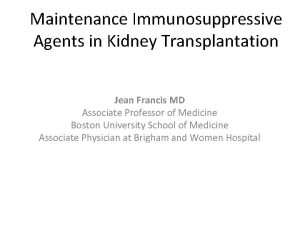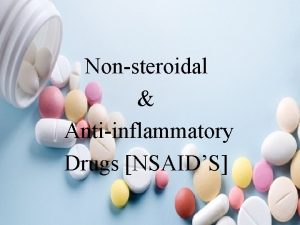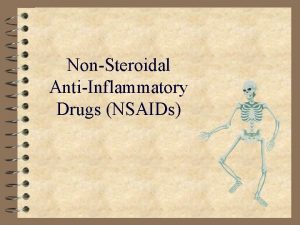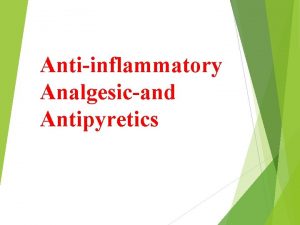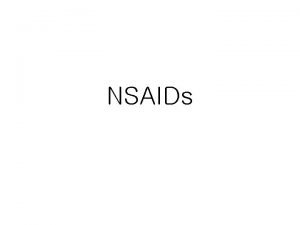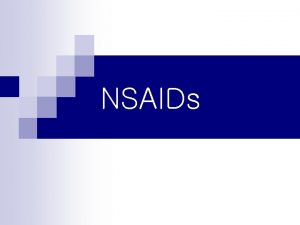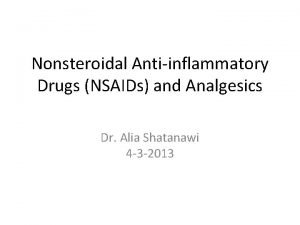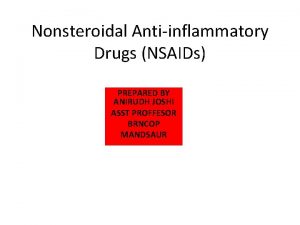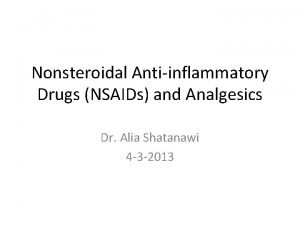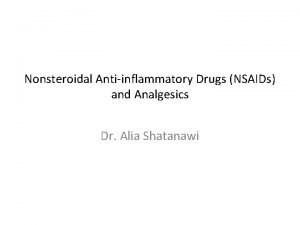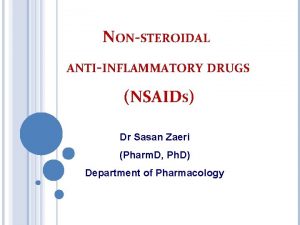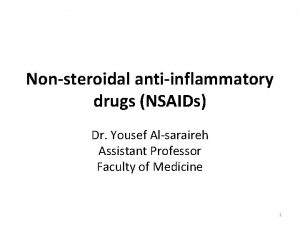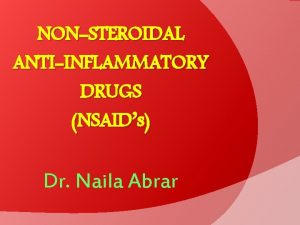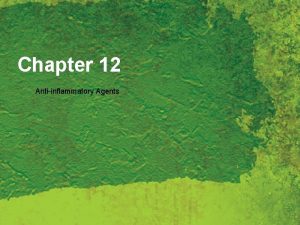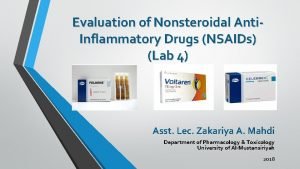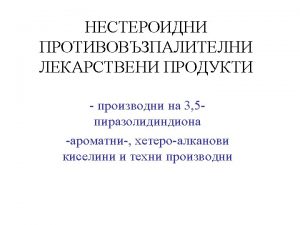NONSTEROIDAL ANTIINFLAMMATORY DRUGS NSAIDS NONSTEROIDAL ANTIINFLAMMATORY DRUGS NSAIDs





















- Slides: 21

NONSTEROIDAL ANTIINFLAMMATORY DRUGS NSAIDS

NONSTEROIDAL ANTIINFLAMMATORY DRUGS (NSAIDs) q. Aspirin: (Acetyl salicylic acid ) �Aspirin and other nonsteroidal anti-inflammatory drugs are weak organic acids. �They all inhibit prostaglandin biosynthesis. �They decrease the production of free radicals and of superoxide and may interact with adenylyl cyclase to alter the cellular concentration of c. AMP. �Aspirin is the drug of choice for treating the majority of articular and musculoskeletal disorders. �It is also the standard against which all anti- inflammatory agents are compared.

Pharmacokinetics: § The salicylates are rapidly absorbed from the stomach and upper small intestine. § The acid medium in the stomach keeps a large fraction of the salicylate in the nonionized form, promoting absorption. § However, the drug may damage the mucosal barrier. § Aspirin is absorbed as such and is rapidly hydrolyzed to acetic acid and salicylate by esterases in tissue and blood. § Salicylate is bound to albumin. § Ingested salicylate and that generated by the hydrolysis of aspirin may be excreted unchanged, but most is converted to water-soluble conjugates that are rapidly cleared by the kidney. § Alkalinization of the urine increases the rate of excretion of free salicylate.

PGE 2, PGF 2, TXA 2, PGI 2



Pharmacodynamics �Mechanism of Action: Aspirin irreversibly blocks the enzyme cyclooxygenase; the drug decreases the formation of both the prostaglandins and thromboxane A 2 but not the leukotrienes. q. Anti-inflammatory Effects: In addition to reducing the synthesis of eicosanoid mediators, aspirin also interferes with the chemical mediators of the kallikrein system. Thus, aspirin inhibits granulocyte adherence to damaged vasculature, stabilizes lysosomes, and inhibits the migration of polymorphonuclear leukocytes and macrophages into the site of inflammation. q. Analgesic Effects: Aspirin is most effective in reducing pain of mild to moderate intensity. Muscular, vascular, and dental origin, postpartum states, arthritis, and bursitis are alleviated by aspirin. �Aspirin acts peripherally through its effects on inflammation but probably also inhibits pain stimuli at a subcortical site.

Pharmacodynamics q. Antipyretic Effects: Aspirin reduces elevated temperature. The fall in temperature is related to increased dissipation of heat caused by vasodilation of superficial blood vessels. The �antipyresis may be accompanied by profuse sweating. �Aspirin blocks the pyrogen-induced production of prostaglandins and the central nervous system response to interleukin-1. q. Platelet Effects: Aspirin inhibits platelet aggregation by inhibition of thromboxane synthesis. �Because its action is irreversible, aspirin inhibits platelet aggregation for up to 8 days (until new platelets are formed).

Clinical Uses • Analgesic, antipyretics, and anti-inflammatory effects: Aspirin is one of the most frequently employed drugs for relieving mild to moderate pain of varied origin. • Aspirin is not effective in the treatment of severe visceral pain (acute abdomen, renal colic, pericarditis, or myocardial infarction). • It and other NSAIDs have been combined with opioid analgesics for treatment of cancer pain. • Used in the treatment of rheumatoid arthritis, rheumatic fever, and other inflammatory joint conditions. • Inhibition of platelet aggregation: Aspirin has been shown to decrease the incidence of transient ischemic attacks and unstable angina in men. • It reduces the incidence of thrombosis in coronary artery bypass grafts. It may also reduce the incidence of myocardial infarction.

Adverse Effects • Gastrointestinal Effects: the main adverse effect is gastric upset (intolerance). • The gastritis that occurs with aspirin may be due to irritation of the gastric mucosa by the undissolved tablet, to absorption in the stomach of nonionized salicylate, or to inhibition of protective prostaglandins. • Central Nervous System Effects: With higher doses, patients may experience "salicylism“ tinnitus, decreased hearing, and vertigo reversible by reducing the dosage. • Still larger doses of salicylates cause hyperpnea through a direct effect on the medulla. • At toxic levels, respiratory alkalosis may occur as a result of the increased ventilation. • Later, acidosis supervenes from accumulation of salicylic acid derivatives and depression of the respiratory center.

Adverse effects • Other Adverse Effects: Aspirin in a low daily dose usually increases serum uric acid levels, whereas doses exceeding 4 g daily decrease urate levels below 2. 5 mg/d. L. • Salicylates may cause reversible decrease of glomerular filtration rate in patients with underlying renal disease. • Asprin is contraindicated in children with upper respiratory tract infections, because it may precipitate Raye syndrome.


Newer Nonsteroidal Anti-Inflammatory Drugs �The newer NSAIDs inhibit of biosynthesis of prostaglandins. �In addition they inhibit chemotaxis, down-regulate interleukin-1 production, and interfere with calcium-mediated intracellular events. �These drugs are reversible inhibitors of cyclooxygenase. �Most of these drugs are well absorbed. �Most of the NSAIDs are highly metabolized, some by phase I and phase II mechanisms and others by direct glucuronidation (phase II) alone. �While renal excretion is the most important route, all undergo varying degrees of biliary excretion and reabsorption (enterohepatic circulation). �All of the NSAIDs are highly protein-bound, usually to albumin.

Newer Nonsteroidal Anti-Inflammatory Drugs �Ibuprofen. �Diclofenace sodium. �Sulindac. �Mefenamic acid. �Piroxicam. �Indomethacin. �Nimesulide. �Rofecoxib.


Pharmacokinetics: • Celecoxib is readily absorbed after oral administration • It is extensively metabolized in the liver by cytochrome P 450 (CYP 2 C 9) and is excreted in feces and urine. • The half-life is about 11 hours, and the drug may be dosed once or twice daily. • The dosage should be reduced in those with moderate hepatic impairment, and celecoxib should be avoided in patients with severe hepatic or renal disease.

Adverse effects: �Headache, dyspepsia, diarrhea, and abdominal pain are the most common adverse effects. �Celecoxib, when used without concomitant aspirin therapy, is associated with less GI bleeding and dyspepsia than other NSAIDs. �However, this benefit is lost when aspirin is added to celecoxib therapy. �Patients who are at high risk of ulcers and require aspirin for cardiovascular prevention should avoid the use of celecoxib.

Acetaminophen (paracetamol) �Acetaminophen (N-acetyl-p-aminophenol or APAP) �inhibits prostaglandin synthesis in the CNS. This explains its antipyretic and analgesic properties. Acetaminophen has less effect on cyclooxygenase in peripheral tissues (due to peripheral inactivation), which accounts for its weak anti-inflammatory activity. �Acetaminophen does not affect platelet function or increase bleeding time. It is not considered to be an NSAID.

Therapeutic uses • Acetaminophen is a suitable substitute for the analgesic and antipyretic effects of NSAIDs for those patients with gastric complaints/risks, in those whom a prolongation of bleeding time is not desirable, as well as those who do not require the anti-inflammatory action of NSAIDs. • Acetaminophen is the analgesic/antipyretic of choice for children with viral infections or chickenpox.

Adverse Effects: • It is hepatotoxic (contraindicated in patients with known liver diseases), and • also causes hemolytic anemia and methemoglobinemia

 Chapter 44 antiinflammatory and antigout drugs
Chapter 44 antiinflammatory and antigout drugs Nsaids classification
Nsaids classification Gastritis x ray
Gastritis x ray Miosis
Miosis Antithyroid drugs classification
Antithyroid drugs classification Rosita rodriguez
Rosita rodriguez Chemoreceptor trigger zone receptors
Chemoreceptor trigger zone receptors Pupils on drugs chart
Pupils on drugs chart Digestants drugs
Digestants drugs Drugs causing hypoglycemia mnemonic
Drugs causing hypoglycemia mnemonic Storage of crude drugs
Storage of crude drugs Antifungal tablets
Antifungal tablets Apparent volume of distribution
Apparent volume of distribution Blood bank regulation under drugs and cosmetics act
Blood bank regulation under drugs and cosmetics act Nifidipin
Nifidipin Barbiturates moa
Barbiturates moa Evaluation of crude drugs
Evaluation of crude drugs Types of drugs
Types of drugs Calcium channels
Calcium channels Difference between oral and parenteral route
Difference between oral and parenteral route Classification of antihypertensive drugs with examples
Classification of antihypertensive drugs with examples Rapamune
Rapamune

